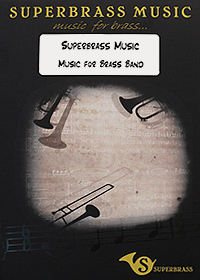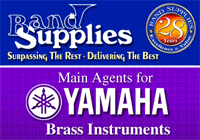Joseph Horovitz 80th Celebration (2 Reviews)
7-Jun-2006Royal College of Music
Friday 26th May
Delightfully idiomatic instrumentation in a unique neo classical-jazz synthesis give the brass and wind music of Joseph Horovitz its sparkle and communicability, qualities attested at the 80th Birthday Celebration for Joseph Horovitz at the Royal College of Music on 26 May.
The concert was performed superbly by leading ensembles of the Royal College of Music to a large and enthusiastic audience, in the presence of the composer, one of several conductors. While his works cover a vast spectrum of genres including chamber music (his fifth string quartet featured in the Park Lane Group's recent Jubilee Season), ballets and operas (most recently Ninotchka, based on the 1939 MGM film starring Greta Garbo), it is to the repertoire of brass and wind music that Horovitz has made a particularly significant contribution. This programme reflected both the serious and lighter aspects of Horovitz's oeuvre, from the early, burlesque Music Hall Suite of 1964 to the compellingly expressive Ad Astra, a 1990 RAF commission for the 50th Anniversary of the Battle of Britain.
The Sinfonietta (1971), the first of Horovitz's many National Brass Band Championship test pieces, formed a scintillating overture. Zone One Brass, under the baton of RCM Head of Brass Nigel Black projected its propulsive main theme with excitement and suspense, while the pastoral slow movement flowed with sheer enjoyment around harmonic highways and byways, leading to an explosive finale. More overtly neo-baroque was the Concertino Classico, commissioned for the 1985 Bach Tercentenary. Cornet soloists Gemma Fuller and Lucy Leleu, conducted by RCM graduate Simon Dobson, projected their frothy counterpoint with panache, and, as in a remix of Bach's double violin concerto, with ravishing lyricism in the aria-like slow movement.
The popular Music Hall Suite, played by the Anglo-Portuguese Quintet, was full of punchy humour and vitality in the faster dances, but the expressive highlight of the concert was Ad Astra, inspired autobiographically on Horovitz's memory of the Blitz in London as a teenage Jewish-Austrian refugee in Britain. The RCM Wind Orchestra conducted by RCM Head of Winds Janet Hilton brought plenty of dramatic tension to the richly elegiac textures contrasted by threatening thematic elements, with echoes of Walton, Finzi, even Strauss. Particularly effective was the final paragraph where a solo trumpet taps out a morse code SOS while clarinets spiral in ascending triads suggesting a lone fighter-pilot's spiral towards the stars.
The composer himself took the podium to conduct, with youthful verve, two of the most demanding works. Zone One Brass's performance of the virtuoso Ballet for Band underlined the varied moods, notably the ‘Till Eulenspiegel' horns of the first movement, a dreamy slow waltz movement, and a brilliantly ironic finale, with burlesque trombones. The RCM Wind Orchestra's performance of Dance Suite 1991 was equally impressive, the tripping slow movement infused with Mahlerian, even Straussian echoes. It concluded a worthy birthday tribute to one of the RCM's most distinguished Professors and Fellows, whose works continue to inspire generations of composers and musicians, and delight audiences the world over.
© 2006 Malcolm Miller
Joseph Horovitz:
An 80th Birthday Celebration
Royal College of Music
London
Friday 26th May.
In a year in which the musical world is placing much emphasis on Mozart's 250th Anniversary, it is good to be able to celebrate a living composer on the occasion of his 80th birthday. A very respectable audience for a Friday night in central London gathered at the Royal College of Music, in the presence of the composer, with the music provided by Zone One Brass, the rather extravagantly named Anglo-Portuguese Brass Quintet and the Royal College of Music Wind Orchestra. Conducting duties were shared between Simon Dobson, Nigel Black, Janet Hilton and Joseph Horovitz himself, whose sprightly appearance and alert direction certainly belied his age.
The first half was devoted to three of his compositions for brass band, played by Zone One Brass, commencing with the "Sinfonietta". This three movement work was written between 1968 and 1970, published in 1971 and chosen for the 2nd Section Regionals in 1972.
It was his first work for brass band, although it was preceded by several pieces for orchestral brass, mainly penned at the urging of Philip Jones. Under the direction of Nigel Black, Head of Brass at the RCM, the band caught the impish character of the opening "Allegro" well, with melodic fragments passing neatly around the band. The balance of the band was generally very good, although the horn sound was a little lost at times.
The "Lento moderato" was well controlled, demonstrating fine playing at low dynamics, and creating a calm and restful atmosphere, although the sound was somewhat on the straight side, and could have been warmer. A finely graded crescendo was led by the trombones before the music died away towards the end of the movement.
The "Con brio" was presented with a real sense of exuberance, with confidence shown throughout the band., who played within themselves, but with real character.
Zone One's founder, the charismatic Simon Dobson, took over the baton for "Concertino Classico", with Gemma Fuller and Lucy Leleu the trumpet soloists. Commissioned in 1985 for the Hjorring Brass Band in Denmark, the two soloists play equal roles, and the style of the music is influenced by the compositions of Bach, Handel & Scarlatti, whose tercentenaries fell in that year.
Although the two soloists were standing at the front of the stage, their sound was occasionally swamped by the accompaniment, which was a little louder than necessary at times. The solo lines in the opening "Con brio" dove-tailed neatly, and the articulation was clean, even in the bottom register.
In the central "Larghetto" the soloists were featured in turn, with a particularly warm sound when they played together, matching their tones and with a more sympathetic backing from the band. The final "Allegro rustico" was presented with a full-blooded approach from both soloists and band, which paid dividends as the work ended triumphantly.
The third brass band item was "Ballet for band", commissioned as the Championship Section test piece in 1983, on which occasion the prize was taken by the Cory Band. Although the composer had specific characters and scenario in mind, he explains that he prefers the audience to exercise its own imagination. Joseph Horovitz received a warm reception as he bounded onto the stage, and led the band into the opening bars, played confidently, with clearly marked rhythms, the players revelling in the unusual chord structures.
The tuba quartet coped well, and the various duet pairings seemed to catch the character of the music effectively. There was also some fine work from the trombone section and soprano. In the slower sections, melodic lines were sustained and smooth, and dynamics were carefully observed throughout, with a telling contribution from the percussion section. The sound of the band was full and clear at both high and low levels, and the performance overall was very satisfying.
As the composer and band acknowledged the applause, two members of the band left the stage and returned with a framed Zone One banner, which was presented as a memento of the occasion. The band had been working with the composer over the previous couple of weeks, and he expressed his own pleasure during the interval at the way they had tackled what is still a major test for any band. It was an impressive performance, especially in the light of a couple of positional changes and the lack of full attendance at the rehearsals due to other work and college commitments. They will now be looking to their future, with the impending departure of Simon Dobson to his native Cornwall.
The second half opened with the "Music Hall Suite" for brass quintet. Although associated in many people's minds with the Philip Jones Brass Ensemble it was actually composed in 1964 at the behest of American tuba player Roger Bobo. The performers were the Anglo-Portuguese Brass Quintet, consisting of Antonio Pacheco and Alan Blair (trumpets), Nicholas Hough (French horn), Andrew Gourlay (trombone) and Mark Grainger (tuba). The five movements each illustrate aspects of the Burlesque Theatre, and the music is full of character.
In "Soubrette Song" there was much use of rubato, particularly in the various solo passages, and the group supported one another effectively. "Trick cyclists" included some very lively interchanges, with each soloist highlighted in turn, the whole given a firm foundation by Mark Grainger on tuba. For "Adagio team" the lines were beautifully sustained, with some good high register tuba playing, and with the final chord slightly held back.
"Soft shoe shuffle" was marked by some "wa-wa" effects from horn and trombone, who were first class in this movement. Playing throughout was extremely accurate, yet retaining a feeling of spontaneity. "Les girls" brought up the rear with precise playing linked with a tremendous sense of fun. This work was greatly enjoyed by all present, and the players clearly have an excellent rapport one with another.
The last group to take the stage was the Royal College of Music Wind Orchestra, initially under the direction of clarinettist Janet Hilton, who is Head of Woodwind at the College. "Ad Astra" was written to mark the 50th anniversary of the Battle of Britain, in response to a commission by the Royal Air Force Music Services. The premiere was given by the Central Band of the Royal Air Force at Westminster Abbey in 1990.
A hymn-like pastoral theme alternates with a sharply angular "metallic" motif, and the piece opens with euphonium and saxophone sharing the melody. There were some problems with intonation in the opening bars, particularly in the clarinets, but things soon settled down, and at higher volumes especially the group produced a pleasant, balanced sound. Solo lines were nicely pointed, with impressive work by bassoon, oboes, alto and tenor sax and clarinet. The music seemed to move inexorably forward, and one could readily imagine the impact it would have had at the Abbey premiere.
In contrast, the "Dance Suite" is much livelier, with various dance styles influencing the sections. It was composed in 1991 for the world famous Tokyo Kosei Wind Orchestra and premiered under the late Frederick Fennell, so prominent in the development of wind repertoire in the 20th century. In addition to the standard wind instruments, there are prominent pats for harp and string bass, whilst the small Eb clarinet adds its distinctive tones to the colourful orchestration. The "Allegro" unusually combines elements of the march with the gavotte, the juxtaposition of styles working surprisingly well. Following an opening burst of sound, oboes and saxophones combine to present the theme.
The central "Andantino" featured some delicate phrasing and well placed flute runs, whilst the full sound of the ensemble was heard at its best in the reprise of the main theme at the end of the movement. In the final "Vivace" a fast 6/8 tarantella in rondo form alternates with a rustic theme in 2/4, although there is also a strong Latin-American influence. All sections of the group had their chance to shine, but one rising unison phrase on the horns was particularly striking. It certainly made for an upbeat end to a most enjoyable concert, a suitably lively celebration of a composer who is obviously still so full of energy.
As the composer, who had directed the final piece, received the acclaim of the audience, it was a little surprising that there was no spoken tribute, which made it seem a little low-key, although there was a group of "official" guests closeted in the gallery of the concert hall. There was nothing low-key about the musical experience, however, and two of the attendees were overheard at the tube station as they made their way home, commenting that it was good to see everybody leaving the hall with a smile on their faces.
When that is linked with the experience the students had gained in working with the composer, then it was a very fitting tribute indeed. Although it is a pity there was no space to include the "Euphonium Concerto", it is good to know that it is shortly to be recorded by Steven Mead in the version with orchestral accompaniment.
Peter Bale









